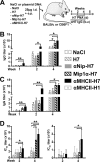A DNA Vaccine That Targets Hemagglutinin to Antigen-Presenting Cells Protects Mice against H7 Influenza
- PMID: 28931687
- PMCID: PMC5686743
- DOI: 10.1128/JVI.01340-17
A DNA Vaccine That Targets Hemagglutinin to Antigen-Presenting Cells Protects Mice against H7 Influenza
Abstract
Zoonotic influenza H7 viral infections have a case fatality rate of about 40%. Currently, no or limited human to human spread has occurred, but we may be facing a severe pandemic threat if the virus acquires the ability to transmit between humans. Novel vaccines that can be rapidly produced for global distribution are urgently needed, and DNA vaccines may be the only type of vaccine that allows for the speed necessary to quench an emerging pandemic. Here, we constructed DNA vaccines encoding the hemagglutinin (HA) from influenza A/chicken/Italy/13474/99 (H7N1). In order to increase the efficacy of DNA vaccination, HA was targeted to either major histocompatibility complex class II molecules or chemokine receptors 1, 3, and 5 (CCR1/3/5) that are expressed on antigen-presenting cells (APC). A single DNA vaccination with APC-targeted HA significantly increased antibody levels in sera compared to nontargeted control vaccines. The antibodies were confirmed neutralizing in an H7 pseudotype-based neutralization assay. Furthermore, the APC-targeted vaccines increased the levels of antigen-specific cytotoxic T cells, and a single DNA vaccination could confer protection against a lethal challenge with influenza A/turkey/Italy/3889/1999 (H7N1) in mice. In conclusion, we have developed a vaccine that rapidly could contribute protection against a pandemic threat from avian influenza.IMPORTANCE Highly pathogenic avian influenza H7 constitute a pandemic threat that can cause severe illness and death in infected individuals. Vaccination is the main method of prophylaxis against influenza, but current vaccine strategies fall short in a pandemic situation due to a prolonged production time and insufficient production capabilities. In contrast, a DNA vaccine can be rapidly produced and deployed to prevent the potential escalation of a highly pathogenic influenza pandemic. We here demonstrate that a single DNA delivery of hemagglutinin from an H7 influenza could mediate full protection against a lethal challenge with H7N1 influenza in mice. Vaccine efficacy was contingent on targeting of the secreted vaccine protein to antigen-presenting cells.
Keywords: APC-targeting; DNA vaccine; avian viruses; hemagglutinin; influenza; pandemic influenza.
Copyright © 2017 Andersen et al.
Figures






Similar articles
-
Efficient vaccine against pandemic influenza: combining DNA vaccination and targeted delivery to MHC class II molecules.Expert Rev Vaccines. 2015 Jun;14(6):805-14. doi: 10.1586/14760584.2015.1029919. Epub 2015 Mar 27. Expert Rev Vaccines. 2015. PMID: 25818107 Review.
-
A Bivalent Heterologous DNA Virus-Like-Particle Prime-Boost Vaccine Elicits Broad Protection against both Group 1 and 2 Influenza A Viruses.J Virol. 2017 Apr 13;91(9):e02052-16. doi: 10.1128/JVI.02052-16. Print 2017 May 1. J Virol. 2017. PMID: 28179535 Free PMC article.
-
Optimal designs of an HA-based DNA vaccine against H7 subtype influenza viruses.Hum Vaccin Immunother. 2014;10(7):1949-58. doi: 10.4161/hv.28795. Hum Vaccin Immunother. 2014. PMID: 25424804 Free PMC article.
-
Inactivated H7 Influenza Virus Vaccines Protect Mice despite Inducing Only Low Levels of Neutralizing Antibodies.J Virol. 2017 Sep 27;91(20):e01202-17. doi: 10.1128/JVI.01202-17. Print 2017 Oct 15. J Virol. 2017. PMID: 28768855 Free PMC article.
-
A systematic review and meta-analysis of cross-reactivity of antibodies induced by H7 influenza vaccine.Hum Vaccin Immunother. 2020;16(2):286-294. doi: 10.1080/21645515.2019.1649551. Epub 2019 Aug 23. Hum Vaccin Immunother. 2020. PMID: 31419167 Free PMC article.
Cited by
-
APC-Targeted DNA Vaccination Against Reticulocyte-Binding Protein Homolog 5 Induces Plasmodium falciparum-Specific Neutralizing Antibodies and T Cell Responses.Front Immunol. 2021 Oct 18;12:720550. doi: 10.3389/fimmu.2021.720550. eCollection 2021. Front Immunol. 2021. PMID: 34733274 Free PMC article.
-
More Than Just Gene Therapy Vectors: Lentiviral Vector Pseudotypes for Serological Investigation.Viruses. 2021 Jan 31;13(2):217. doi: 10.3390/v13020217. Viruses. 2021. PMID: 33572589 Free PMC article. Review.
-
Applying valency-based immuno-selection to generate broadly cross-reactive antibodies against influenza hemagglutinins.Nat Commun. 2024 Feb 12;15(1):850. doi: 10.1038/s41467-024-44889-w. Nat Commun. 2024. PMID: 38346952 Free PMC article.
-
Pandemic Preparedness Against Influenza: DNA Vaccine for Rapid Relief.Front Immunol. 2021 Oct 8;12:747032. doi: 10.3389/fimmu.2021.747032. eCollection 2021. Front Immunol. 2021. PMID: 34691056 Free PMC article.
-
Recent advances in antigen targeting to antigen-presenting cells in veterinary medicine.Front Immunol. 2023 Mar 10;14:1080238. doi: 10.3389/fimmu.2023.1080238. eCollection 2023. Front Immunol. 2023. PMID: 36969203 Free PMC article. Review.
References
-
- World Health Organization. 2017. Influenza at the human-animal interface, June 2017: monthly risk assessment summary, p 1–7 World Health Organization, Geneva, Switzerland.
-
- Fouchier RaM, Schneeberger PM, Rozendaal FW, Broekman JM, Kemink SaG, Munster V, Kuiken T, Rimmelzwaan GF, Schutten M, Van Doornum GJJ, Koch G, Bosman A, Koopmans M, Osterhaus ADME. 2004. Avian influenza A virus (H7N7) associated with human conjunctivitis and a fatal case of acute respiratory distress syndrome. Proc Natl Acad Sci U S A 101:1356–1361. doi:10.1073/pnas.0308352100. - DOI - PMC - PubMed
-
- Zanin M, Koçer ZA, Poulson RL, Gabbard JD, Howerth EW, Jones CA, Friedman K, Seiler J, Danner A, Kercher L, McBride R, Paulson JC, Wentworth DE, Krauss S, Tompkins SM, Stallknecht DE, Webster RG. 2016. The potential for low pathogenic avian H7 influenza a viruses to replicate and cause disease in a mammalian model. J Virol 91:e01934-16. doi:10.1128/JVI.01934-16. - DOI - PMC - PubMed
-
- Zhou L, Ren R, Yang L, Bao C, Wu J, Wang D, Li C, Xiang N, Wang Y, Li D, Sui H, Shu Y, Feng Z, Li Q, Ni D. 2017. Sudden increase in human infection with avian influenza A(H7N9) virus in China, September–December 2016. Western Pac Surveill Response J 8:6–14. doi:10.5365/wpsar.2017.8.1.001. - DOI - PMC - PubMed
MeSH terms
Substances
LinkOut - more resources
Full Text Sources
Other Literature Sources
Medical

